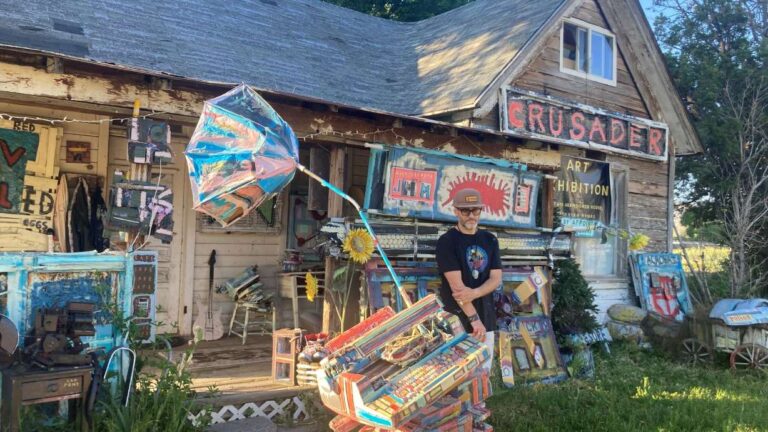SANTAQUIN — It was an unassuming little house on Santaquin’s Main Street, tucked between a Dollar General and a grove of trees. The paint was peeling, the porch was sagging, the front door had been locked for a decade.
That was a hopeless situation until Utah artist Ryan Hymas came along.
He has thrown open the front door of his home, his kaleidoscopic indoor art gallery at 218 W. Main in Santa Quincy, which is open to the public through June 15th.
Hymas has given the house a second life by turning it into a vessel for his own artworks: beautiful yet unsettling, tumultuous yet introspective: he collects, paints, builds, rearranges, destroys and reconstructs.
“Nothing is ever finished. Everything is open to repainting and adding to,” Hymas says, “and we’re not afraid to destroy things we love in order to create something amazing.”
Looking at Hymas’ work, comparisons are made to Marcel Duchamp, Jean-Michel Basquiat and Robert Rauschenberg. If asked to classify it, Hymas would state that it is contemporary abstract.
“But it would be sad to pigeonhole him,” said Hymas’ mother, Marilyn Hymas.
Hymas believes anything can become art. To create his pieces, he has collected car seats, pianos, typewriters, umbrellas, projector screens, chains, and even dead baby birds. He sometimes writes down quotes that he likes and uses them in his work.
“I like the idea of things with history,” he says, “and I try to bring the energy of things from the past into something new.”
Hymas’ own history influences his art. He’s dealt with substance abuse issues for 16 years, and has been sober for 11 now. His day job is with Utah Recovery Services, where he listens to the stories of others struggling with substance abuse. To him, art isn’t just a hobby, it’s a necessity.
“Painting is a tool for me to be in the present,” he says. “Painting calms me.”
It’s also a way for him to navigate big, difficult emotions, and he says he enjoys seeing other people feel their own emotions when they look at his work.
“I know what I think about the piece, but I love seeing other people translate the artwork into their own meaning,” he said.
There is a connection between Hymas, his work and his house. They were all lost and then found.
Hymas wants to help addicts find themselves. A portion of the proceeds from his artwork will be donated to those in need. He plans to help a single mother in recovery with her rent.
“I like art, but it’s not my only interest,” he said. “People are more important than works of art.”
Though Hymas’ work has already reached buyers around the world, he remains steadfast in his determination to create for himself, not for profit, and his approach keeps him from falling into the same patterns.
“I try not to contradict my own preferences so that I don’t get into a creative rut or cycle,” he said.
He welcomes people to view his work for free, and he sometimes discreetly displays his work in unusual locations, such as gas station restrooms and movie theaters.
“I want people to experience it,” he said.



